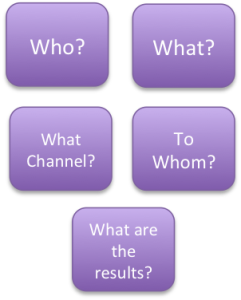3 Defining Communication Study
What is Communication Study?
 When we tell others that we teach Communication, people often ask questions like, “Do you teach radio and television?” “Do you teach public speaking?” “Do you do news broadcasts?” “Do you work with computers?” “Do you study Public Relations?” “Is that Journalism or Mass Communication?” But, the most common question we get is, “What is that?” It’s interesting that most people will tell us they know what communication is, but they do not have a clear understanding of what it is Communication scholars study and teach in our academic discipline. In fact, many professors in other departments on our campus also ask us what it is we study and teach. If you’re a Communication major, you’ve probably been asked the same question, and like us, may have had a hard time answering it succinctly. If you memorize the definition below, you will have a quick and simple answer to those who ask you what you study as a Communication major.
When we tell others that we teach Communication, people often ask questions like, “Do you teach radio and television?” “Do you teach public speaking?” “Do you do news broadcasts?” “Do you work with computers?” “Do you study Public Relations?” “Is that Journalism or Mass Communication?” But, the most common question we get is, “What is that?” It’s interesting that most people will tell us they know what communication is, but they do not have a clear understanding of what it is Communication scholars study and teach in our academic discipline. In fact, many professors in other departments on our campus also ask us what it is we study and teach. If you’re a Communication major, you’ve probably been asked the same question, and like us, may have had a hard time answering it succinctly. If you memorize the definition below, you will have a quick and simple answer to those who ask you what you study as a Communication major.
Ancient Depiction of Human Communication
Bruce Smith, Harold Lasswell, and Ralph D. Casey provided a good and simple answer to the question, “What is Communication study?” They state that, communication study is an academic field whose primary focus is “who says what, through what channels (media) of communication, to whom, [and] what will be the results.”

Although they gave this explanation almost 70 years ago, to this day it succinctly describes the focus of Communication scholars and professionals. As professors and students of Communication, we extensively examine the various forms and outcomes of human communication. On its website, the National Communication Association (NCA), states that communication study “focuses on how people use messages to generate meanings within and across various contexts, cultures, channels and media. The discipline promotes the effective and ethical practice of human communication.” They go on to say, “Communication is a diverse discipline which includes inquiry by social scientists, humanists, and critical and cultural studies scholars.” Now, if people ask you what you’re studying in a Communication class, you have an answer!
In this course we will use Smith, Lasswell, and Casey’s definition to guide how we discuss the content in this book. Part I of this book sets the foundation by explaining the historical development of the Communication discipline, exploring the “what” and “channels” (verbal and nonverbal communication), and presenting the “whom” and “results” (theories and research methods). Before we get into those chapters, it is important for you to know how we define the actual term “communication” to give you context for our discussion of it throughout the book.

